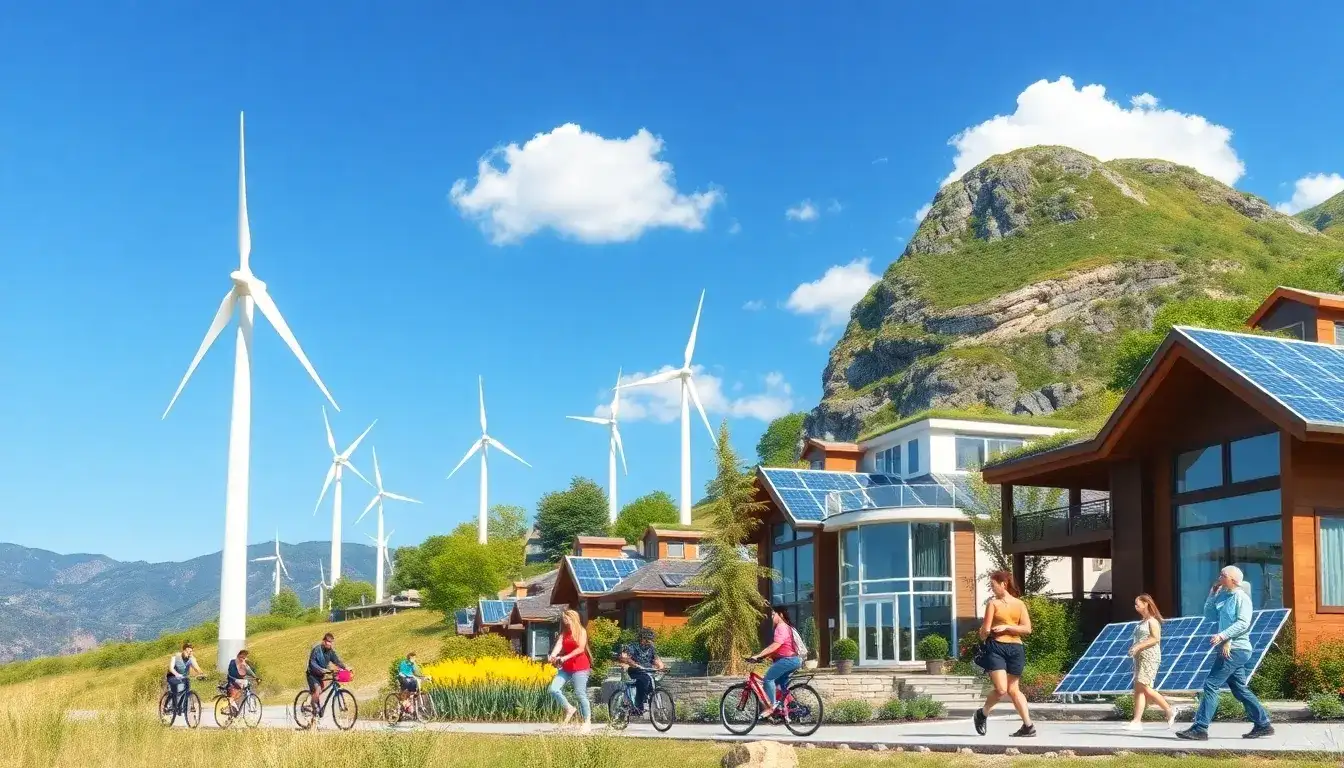
Minning “Pure Green Electric Town” is a notable example of innovative energy solutions, contributing to the sustainable development of renewable energy in China. As of the end of 2024, the installed capacity of renewable energy in China surpassed that of thermal power for the first time. Despite the rapid growth of renewable energy, challenges such as reliance on weather conditions and unstable supply have become increasingly prominent. These issues not only heighten the pressure on renewable energy consumption but also impact the safe and stable operation of the power grid.
To address these challenges, ensuring a stable and continuous supply of renewable energy has become crucial for promoting sustainable development in this sector. At the end of last year, key projects in Minning Town, including a “pure green electric town” energy storage station and a coordinated control system, were completed on schedule, enabling a 24-hour supply of pure green electricity. This new energy storage technology can replace coal power and facilitate the coordinated development of renewable energy generation, storage, transmission, and consumption. It serves as a model for addressing the current challenges facing renewable energy development and acts as a catalyst for rural revitalization in Minning Town, triggering a “chain reaction.”
New Power System Achieves 24-Hour Pure Green Electric Supply
Ningxia boasts unique advantages for renewable energy development. Over the past 15 years, the installed capacity of renewable energy in Ningxia has increased from 850,000 kilowatts in 2010 to over 41 million kilowatts by the end of 2024. In this context, the “pure green electric town” in Minning Town has implemented a series of technological innovations to achieve a continuous 24-hour supply of pure green electricity, effectively compensating for the inherent instability in renewable energy supply. It is projected that this initiative will lead to an additional consumption of 215 million kilowatt-hours of green electricity annually, saving over 26,400 tons of standard coal and reducing carbon dioxide emissions by 73,200 tons.
“We have specifically developed a source-grid-load-storage control system. This system, deployed with intelligent monitoring equipment at the dispatch center, hub substations, renewable energy stations, and energy storage facilities, constructs a dual-layer control architecture for energy management. It enables coordinated control and panoramic monitoring of source-grid-load-storage systems, precise forecasting of renewable energy and load, and intelligent regulation of energy storage charging and discharging,” explained Xu Yong, Secretary of the Party Committee of State Grid Yinchuan Power Supply Company. “With this system in place, during peak sunlight hours, the new energy storage captures excess electricity, and at night, wind energy collaborates with energy storage to maintain a 24-hour supply of green electricity.”
Due to external environmental influences, renewable energy supply can be quite volatile. The new energy storage serves as the “storage” in the source-grid-load-storage framework, stabilizing renewable energy supply through “peak shaving and valley filling.” This component is vital for the new power system and the “pure green electric town” in Minning. It not only enhances the economic benefits of renewable energy by “storing surplus to supplement shortages” but also enables seamless switching between grid-connected and off-grid operations. In case of disruptions in the connection between the local grid and the higher-level grid, it can operate independently, mitigating any adverse effects on renewable energy consumption and ensuring reliable power supply and regional energy security.
Li Hongtao, General Manager of Datang Yongning New Energy Technology Co., Ltd., stated that the two newly constructed energy storage stations in Minning Town, each with a capacity of 100 MWh/200 MWh, function like ultra-large “power banks,” capable of storing 400,000 kilowatt-hours of electricity. With an 85% discharge efficiency, once fully charged, they can supply 340,000 kilowatt-hours of electricity to bridge the gaps during nighttime or periods of insufficient wind energy generation.
Virtual Power Plant: A Key Component of the New Power System
The virtual power plant is also an essential part of the new power system. It is not a traditional physical power plant but rather a system that leverages advanced technologies such as digitization and intelligence to aggregate, coordinate, and optimize adjustable loads, distributed energy sources, and energy storage resources within a specific area. This system is capable of responding to grid operation adjustments.
Ningxia ranks among the top in the country in terms of virtual power plant adjustability. Some electricity-consuming enterprises act as virtual power plants, adjusting their power loads based on the fluctuations in renewable energy generation. This approach enhances the utilization of renewable energy while providing compensation for the enterprises, creating a win-win scenario. By the end of last year, the Ningxia virtual power plant management platform had integrated ten virtual power plants, aggregating adjustable loads from various sources such as electric vehicle charging stations, building air conditioning systems, and ferromanganese enterprises, with a total capacity exceeding 3.79 million kilowatts. The operators of these virtual power plants have collectively earned around 1 million yuan. Following the commissioning of the “pure green electric town,” the successful experiences from Ningxia’s virtual power plants will also support green electricity supply and demand balance in Minning Town, attracting relevant enterprises to settle there.
Effectively Addressing Renewable Energy Development Challenges
Currently, the development of renewable energy in China faces significant challenges such as high consumption pressure and low enthusiasm for new energy storage development. The “pure green electric town” serves as a testbed for renewable energy system development, providing insights for overcoming these difficulties.
To alleviate renewable energy consumption challenges, in 2023, China accounted for over half of the world’s newly installed renewable power generation capacity, with its cumulative installed capacity reaching nearly 40% of the global total. The rapid growth of renewable energy has led to considerable pressure on its consumption. For instance, in Ningxia, as of the end of 2024, renewable energy installed capacity exceeded 41 million kilowatts, with solar power accounting for over 60%. The rapid development of solar energy, accompanied by significant generation fluctuations, has increased the pressure on renewable energy consumption in the region.
He Xing’an, a specialist in the Development Planning Department of State Grid Yinchuan Power Supply Company, indicated that the “pure green electric town,” based on a 100% renewable energy scenario, explores strategies for coordinated operation of source-storage-grid-load systems. This approach aims to enhance the proportion of green electricity consumption in the town while further improving renewable energy utilization rates. Through practical engineering applications, it seeks to address the challenges related to high penetration renewable energy supply-demand balance, creating new experiences for replicating and promoting new power system construction.
Additionally, increasing enthusiasm for new energy storage development is crucial. New energy storage plays an important role in facilitating renewable energy consumption and stabilizing power supply. However, due to unstable policies and rapidly declining costs, there is a perception that early entrants into the new energy storage market incur more losses, which has dampened industry enthusiasm to some extent.
Zeng Bingjie, General Manager of Ningxia Mingyi Green Energy Integrated Service Co., Ltd., stated that the rapid development of renewable energy in China cannot rely solely on coal power for peak shaving, indicating a broad future for new energy storage development. The “pure green electric town” and the construction of the new power system further expand the application scenarios for new energy storage, propelling industry growth. Currently, grid-connected energy storage is relatively costly as a new concept, but it represents the industry’s development trend. As large-scale application increases, costs will continue to decrease, enhancing the technological advantages of new energy storage in China.
Another challenge is the difficulty in tracing the physical sources of green electricity. Currently, green electricity is mixed with coal power in the grid, making it difficult to achieve physical tracing of green electricity, which affects the recognition of green certificates in China. The “pure green electric town” addresses this issue through its continuous supply of green electricity, effectively resolving related challenges and potentially enhancing the “value” of green electricity and green certificates in the country.
Experts noted that after the operation of the “pure green electric town,” all green electricity consumed by enterprises in Minning Town can be traced, helping to enhance the benefits of relevant enterprises.
A Catalyst for Rural Revitalization
Over the past 20 years, with support from Minning’s collaborative assistance, Minning Town has transformed from a “dry sandy beach” into a “golden sandy beach.” Recently, renewable energy has further allowed Minning Town’s dry sandy area to flourish, and the advantages of the “pure green electric town” have become a catalyst for rural revitalization in the region.
The “pure green electric town” accelerates the clean and low-carbon transformation of Minning Town and promotes a shift to green production and lifestyle. It empowers high-quality development of industries such as intelligent manufacturing, deep processing of specialty agricultural products, and facility agriculture in Minning Industrial Park. This initiative injects new momentum into the town’s efforts to build a comprehensive rural revitalization model.
For the residents of Minning Town, the most fundamental wish is to earn a living close to home. The “pure green electric town” employs a model combining “village collective + enterprise + farmer,” establishing large-scale photovoltaic facilities in Yuangong Village and constructing rooftop photovoltaic systems for over 1,600 migrant households in the village. The village collective earns over 2 million yuan annually, with each migrant household receiving rental fees for the rooftops.
Furthermore, the industrial and commercial sectors have long been development weaknesses in Minning Town and impoverished areas. The “pure green electric town” benefits high-energy-consuming industries that have a strong demand for green electricity, bringing new opportunities and advantages for industrial and commercial growth in Minning Town.
For instance, Ningxia Yinghai Tianchen Building Materials Co., Ltd., located within Minning Town, primarily produces cement and cement clinker. In the first eleven months of 2024, the company’s electricity consumption exceeded 36 million kilowatt-hours, with total electricity costs reaching 19 million yuan. After the commissioning of the “pure green electric town,” according to Ningxia’s latest policies, if users engage in bilateral trading to purchase and utilize green electricity entirely, the ideal state could lead to a maximum 12% reduction in electricity costs. The company representative stated that green electricity has triggered a transformation across the entire industry, significantly reducing electricity costs and fundamentally addressing the carbon emissions resulting from high energy consumption in the sector.
Minning Town is rich in wind and solar resources, providing conditions for accommodating more enterprises with high demand for green electricity. Hou Ziqiang, Director of the Development and Reform Commission of Yinchuan City in Ningxia, noted that currently, Minning Town has an installed capacity of around 200,000 kilowatts for renewable energy, generating approximately 300 million kilowatt-hours annually, which exceeds the local average electricity consumption of about 150 million kilowatt-hours per year. Additionally, the region has abundant renewable energy resources, with potential expansion up to about 1 million kilowatts, transforming Minning Town’s wind and solar resources into a continuous driving force for rural revitalization.







